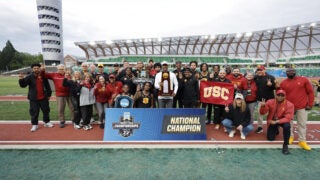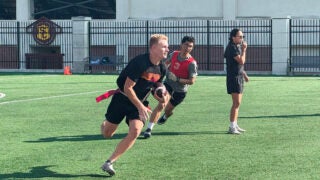Pat Haden updates Coliseum renovation plans
Athletic director addresses possible changes to historic venue
USC recently sent out a survey to various constituents regarding the possible redevelopment of the Coliseum. In this month’s State of Troy message, USC Athletic Director Pat Haden addresses some of the questions he has received regarding the survey.
Why did you send out this survey?
When USC took control of the Coliseum and Sports Arena this past summer, the university and, more specifically, the athletic department became responsible for the operation, maintenance and upgrading of the 91-year-old stadium. USC is required to spend $70 million over a 10-year period for enhancements and improvements to the stadium’s infrastructure. While these improvements will help the Coliseum remain functional, they do not address much-needed improvements to the fan experience. It is not an option to “do nothing.”
Knowing that we have to spend $70 million on the Coliseum, why not investigate all options of what the Coliseum could become?
Knowing that we have to spend $70 million on the Coliseum, why not investigate all options of what the Coliseum could become? That’s the purpose of the survey, to discuss some possibilities and see what our fans will support. This is the time to explore what we want the Coliseum to look like for the next 100 years.
Are you planning to implement everything suggested in the survey questions?
No decisions have been made. We know we need to do something based on the lease mandate and the current condition of the Coliseum. So we have surrounded ourselves with expert consultants to guide us through a feasibility study and examine what possible steps we can take to enhance the facility. We recognized that the first step must be to gauge the appetite of our fan and donor base. This has been done through the release of our survey to nearly 250,000 stakeholders and will continue through the use of focus groups. This will provide telling information about what our fans truly want and what they are willing to support. Certainly not everyone is going to answer the survey the same way, but we, as an athletic department and as a university, must first listen, then digest the information and finally act accordingly in the best long-term interest of the Coliseum and the faithful Trojan fans. We greatly appreciate the thousands of fans who have completed the survey. Positive, negative or indifferent, all of them have been heard and are playing an active role in the possible redevelopment of the Coliseum.
Why does the Coliseum need to be renovated beyond the bare minimum?
Very little has been done to renovate the Coliseum since it was built, except when the field was lowered to add seats in 1993 and when major repair and retrofitting was needed following the 1994 earthquake. If we do nothing beyond the required $70 million in enhancements, the Coliseum will slip decades behind most other premier venues in the country. We will fall short in addressing not only many ongoing issues and problems (life safety, mechanical, electrical, plumbing, general infrastructure, ingress and egress, restroom, concession, audio-visual, football operation, sports medicine, media and technology), but there will be an overall lack of fan amenities. We have recently given facelifts to some of our campus athletic facilities, like Heritage Hall and the Uytengsu Aquatics Center, to the benefit of future generations of student-athletes and the Trojan Family. I believe we can do the same for the Coliseum, while keeping in mind that this is a historic landmark and preservation guidelines must be followed.
What are other benefits of renovation?
Modern stadiums have amenities that we simply cannot provide our fans in the Coliseum’s current state. An updated Coliseum would provide significant opportunities to create long-term revenue generation through less intrusive sponsorship activation. Technology will provide us with a better in-game experience for our fans and sponsors. We want a more intimate environment to improve our home-field advantage by bringing our fans closer to the game, and we will study acoustics and sight-line plans accordingly. We can provide premium experiences through club seats, loge boxes and luxury suites. We can improve the video boards and fix some audio issues. We can enhance the experience for our players by providing a better locker room and medical facility. The media would enjoy an improved press box. And most importantly, fans will have a better overall experience from tailgating to seating to watching the game.
Are fans going to lose their seats or be forced to buy a personal seat license to protect them?
Again, no decisions have been made. As part of our survey, we are receiving valuable feedback from our fans regarding stadium renovation programs that have been pursued by other universities, including personal seat licensing and other topics. There has been a range of opinions, both positive and negative, and those ideas will be considered at every step in the process, including how to honor and recognize previous commitments should seat licenses be imposed in some of the stadium. At the same time, we need to be cognizant that not every longtime USC fan wants a premium option, and we need to provide an affordable experience for those fans. We recognize that the support of the Trojan Family is what makes the environment at USC football games special, and we do not want to make decisions that would change this irrevocably. Our goal is to create a facility that our fans’ children, grandchildren and great-grandchildren can proudly visit.
What is the Coliseum Improvement Fee that is part of current ticket prices and how is this money used?
The Coliseum Improvement Fee, begun in 2012, has allowed us to make some improvements throughout the Coliseum. Over the past two years, we have upgraded the quality of the playing field, added a centralized point of sale system for concessions, improved the connectivity and sound for our guests, and partnered with third-party concessionaires and maintenance professionals. This upcoming season, among other things, we will use the fee to implement advanced technology for ticket scanning, and we will provide new pre- and postgame tailgating opportunities. But the cost of making impactful improvements to fan amenities and the game experience far exceed the annual fees generated by ticket sales and the Coliseum Improvement Fee.
How are other schools handling the problem of aging stadiums?
In the Pac-12 Conference alone, UCLA, Washington, Arizona State, California, Arizona and Washington State all either recently completed or are currently undergoing massive renovation projects. Since 2000, every Pac-12 school has spent between $32 million and $313 million more on stadium improvements than USC. Nationally, schools such as Notre Dame, Texas A&M and Baylor are taking on $100 million to $500 million projects.



